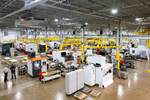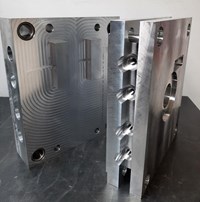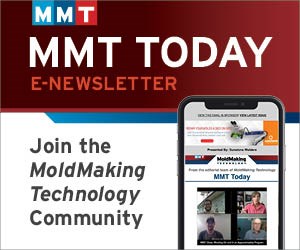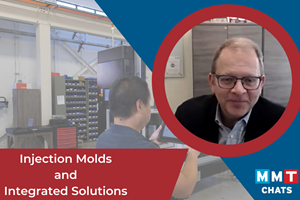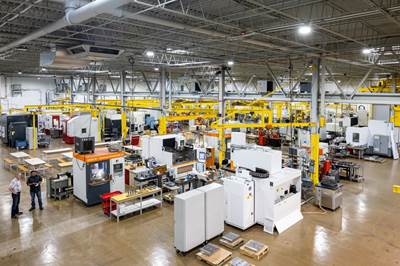Share
Read Next

Helm Tool's collaborative model enables innovative experimentation with new materials, such as compostable plastic, to develop custom solutions. Source (All images) | Helm Tool
Helm Tool has established itself as a key player, not just in producing traditional molds but also in pioneering the use of biodegradable materials. Helm Tool's unique advantage lies in its integrated approach. As both a mold builder and molder — Helm Tool and Intermolding Technology Inc. — the company can quickly test and iterate on designs, providing a full spectrum of services from concept to finished product. This capability has attracted customers looking for innovative solutions, particularly in the area of biodegradable materials.
The company has focused on mastering stainless steel mold construction, ensuring durability and precision. This focus has helped it eliminate issues like cracking in steel inserts, which was a common challenge in the early 2000s. The journey into biodegradable materials began when Helm Tool sought to diversify its offerings and address growing environmental concerns. “I believe that to take advantage of new business opportunities, you must always stay at the forefront of technology, and I see biomaterials as a door to a new opportunity,” says Helmut Mueller, president of Helm Tool.
Challenges in Biomaterial Mold Design and Processing
Currently, Helm Tool is exploring the potential of creating products that have a one-time usage from biomaterials that could dissolve over time. While still in the early stages, this initiative demonstrates its commitment to sustainable manufacturing practices. However, challenges remain, particularly in scaling up these innovations to full production levels.
In most cases, Helm builds one-cavity prototypes for these materials. “Some of the prototypes work, while others don't because the parts are either too soft, deform or don’t fill correctly. Temperature and injection pressure are crucial as some of these materials are much harder to inject into the mold. You have to be more precise when building the mold because they flash very easily. With just 2/10 of an inch, they start flashing already,” Mueller says.
“For a lot of it, you must forget what you were told is the way to make parts in the past. If you don't, you're not going to be successful, and even the best machine and the best mold will not help.”
This means the customer must either make smaller molds to run in existing presses or buy even bigger presses to run a big mold. Roland Kuehtreiber, plant manager of Intermolding Technology Inc., agrees, saying, “Converting products to a different material can cause issues for molders due to the sensitivity to heat, which may require them to either modify their current presses, reduce the injection unit size or invest in new presses with smaller injection units. The clamp tonnage needed for these products will be higher compared to what is needed for a polystyrene or polypropylene part.” Mueller and Kuehtreiber believe it will take a lot more development over the next few years to find easier solutions.

Building molds for biodegradable materials requires precision, as they flash easily with just 2/10 of an inch.
Despite not having official partnerships with research groups, Helm Tool collaborates closely with materials compounders and customers, often under strict non-disclosure agreements. This collaborative model enables it to experiment with new materials, including compostable plastic and develop custom solutions.
Working with biodegradable materials involves significant trial and error. Helm Tool often deals with prototype materials that lack comprehensive rheological data, requiring a hands-on approach to testing and refining. This iterative process sometimes requires adjustments to both the molds and the machinery being used, emphasizing the complex nature of working with these innovative materials.
“It often comes down to a compound being created and the customer wanting to sample it right away. Most of them don’t have any rheology data at that point. The time from when they believe they have a viable product to when we can provide a sample is typically just hours or days, not weeks. There isn’t enough time for lab work to gather data. The focus is really on how the material behaves and how the product performs in composting tests, as well as its mechanical properties after manufacturing,” says Mueller.

Helm Tool envisions compostable materials shaping the future, requiring technical solutions and significant investment.
These materials impact the mold design as well. “For example, the company builds stronger molds to handle the higher injection pressure when making plastic parts with these new materials.Then when it comes to processing these materials, there's no training or documentation available yet,” says Kuehtreiber.
There are no papers or resources you can use to teach yourself. If you used to be a traditional polypropylene or polystyrene manufacturer, you have to forget what you were told to do and adjust to something totally new.
“The process, pressures, fill times, cooling times — everything has to be reconsidered depending on what material group you're working with. PLA is totally different from PHA, so you have to learn and adjust. For a lot of it, you must forget what you were told is the way to make parts in the past. If you don't, you're not going to be successful, and even the best machine and the best mold will not help,” says Mueller.
Future of Compostable Manufacturing
Looking ahead, Helm Tool sees a future where compostable materials play a significant role in the industry. However, it acknowledges widespread adoption will require more than just technical solutions; it will also need significant investment in specialized equipment and processes. The company's experience has shown that successful mold building, particularly with new materials, requires a deep understanding of both the materials and the manufacturing processes.

Helmut Mueller, president of Helm Tool (right) and Roland Kuehtreiber, plant manager of Intermolding Technology Inc.(left), believe staying at the forefront of technology opens new business opportunities, with biomaterials as a key door to the future.
“Very few of the big companies are developing compostable materials right now. It's mostly small compounders or new startups. I believe that eventually when someone develops a good recipe, a big company will buy them up. It's not a mass market yet. It's a small niche right now,” says Mueller.
As the market for compostable materials grows, Helm Tool is poised to lead the charge. Armed with decades of experience, state-of-the-art equipment and a willingness to explore new frontiers in mold building and material science, the company’s story showcases the importance of innovation, adaptability and a commitment to quality in mold manufacturing.
Related Content
VIDEO: Sustainable Molding and Advanced Gating
Hot runner supplier emphasizes sustainability in bio-resin molding, custom side gating and valve gate technologies.
Read MoreMMT Chats: Injection Molds and Integrated Solutions Through Ambition and Innovation
Jordan Robertson, VP, Business Development and Marketing for StackTeck discusses various mold technologies to improve efficiencies in automation, cooling, lightweighting and sustainability.
Read MoreMMT Chats: Sustainable Workforce Growth with the ATR Framework
Join MoldMaking Technology Editorial Director Christina Fuges as she discovers the benefits of eLearning, including promoting sustainability in moldmaking by reducing travel, minimizing waste and enhancing global workforce accessibility.
Read MorePerspectives on Sustainability in Mold Building: A Diverse Outlook
In conversations with individuals involved in the mold building industry, a variety of perspectives on sustainability emerged, showcasing the multifaceted nature of the term.
Read MoreRead Next
Cross Training, In-House Capabilities and Collaborative Design Move Helm Tool Forward
Cross-training, bringing it all in-house, molding and collaborative design are essential to Helm Tool's success.
Read MoreEmbracing ESG: One Mold Builder's Path to Sustainability and Success
The story of how a company in the moldmaking, injection molding and metal parts industry is navigating the challenges and opportunities associated with sustainability.
Read MoreMMT Chats: Exploring Sustainable Innovation & Advanced Technology: The Plastek Group's Injection Blow Mold Project & More
MoldMaking Technology Editorial Director Christina Fuges interviews VP Global Engineering & Tooling Doug Prischak and VP of Sales John Heinrikson from The Plastek Group and Triangle Tool about an injection blow mold project, sustainability, imaging, AR and 3D printing.
Read More


